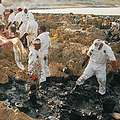 聯合國環境規劃署(UNEP)的報告指出,2006年夏季真主黨與以色列之間的衝突,導致黎巴嫩當局面臨嚴重且範圍廣的環境問題。不過,所幸這些衝突中所使用的飛彈,都不屬於貧鈾或其他含有輻射物質的武器。
聯合國環境規劃署(UNEP)的報告指出,2006年夏季真主黨與以色列之間的衝突,導致黎巴嫩當局面臨嚴重且範圍廣的環境問題。不過,所幸這些衝突中所使用的飛彈,都不屬於貧鈾或其他含有輻射物質的武器。
聯合國環境規劃署執行長史坦納(Achim Steiner)表示:「這篇報告對於黎巴嫩政府與人民所面臨的嚴重環境問題,有清楚詳細的描述。像是戰爭殘骸、農田裡的炸彈碎片、工廠遭炸毀或燒毀留下的有毒廢棄物,以及到處都有的水源污染、污水排放系統污染危機等,都需要緊急的處理行動。」
「還有許多長期的自然環境工作,包含在一些主要地點,需要有系統的監控當地居民健康以及環境的狀況。」史坦能說道。
報告當中提到,需多工廠及工業設施,包括貝魯特南部的吉耶發電廠,在遭受轟炸或燒毀後,都有嚴重的毒物及危險物質污染。
清除這些污染物質並且移置到安全地點的工作非常緊急,因為灰燼及滲漏的化學物質將威脅到水源以及人民的健康。
其中主要的關注地點有:許多區域遭受轟炸的索菲亞特工業區、貝魯特國際機場,以及位於提爾的Ghabris工業洗滌劑工廠。
這些區域充滿了有毒或危險的灰燼、油污、重金屬、工業化合物、斷垣殘壁、固體廢棄物以及廢污水。這些物質將會危害到清理工人,及地方居民的健康。
Urgent widespread environmental problems confront the Lebanese authorities as a result of the conflict between Hezbollah and Israel last summer, finds a report issued today by the United Nations Environment Programme, UNEP. On the positive side, the missiles used in the conflict did not contain depleted uranium or any other kind of radioactive material.
UNEP Executive Director Achim Steiner said, "The report provides a comprehensive picture of the outstanding environmental problems facing the Lebanon and its people. Some of these, like war-related debris, cluster bombs on farmland, toxic waste - the result of bomb damage and fires at industrial facilities - and the widespread damage to water and sewage systems require urgent remedial action."
"Others are more long-term in nature including the necessity for systematic monitoring of the health of local populations, and the environment, in certain key locations," Steiner said.
Many of the bombed and burned out factories and industrial complexes including the Jiyeh power plant south of Beirut, are contaminated with toxic and hazardous substances, says the report.
Urgent action is needed to remove and safely dispose of these substances, which include ash and leaked chemicals, amid concerns they represent a threat to water supplies and public health.
The main hot spots of concern are the Choueifat industrial area where a cluster of sites was bombed, Beirut’s International Airport, and the Ghabris detergent factory in Tyre.
At these sites there are toxic or hazardous ashes, oils, heavy metals, industrial chemicals, rubble, solid waste and sewage. These may pose health risks to cleanup workers and local communities.


